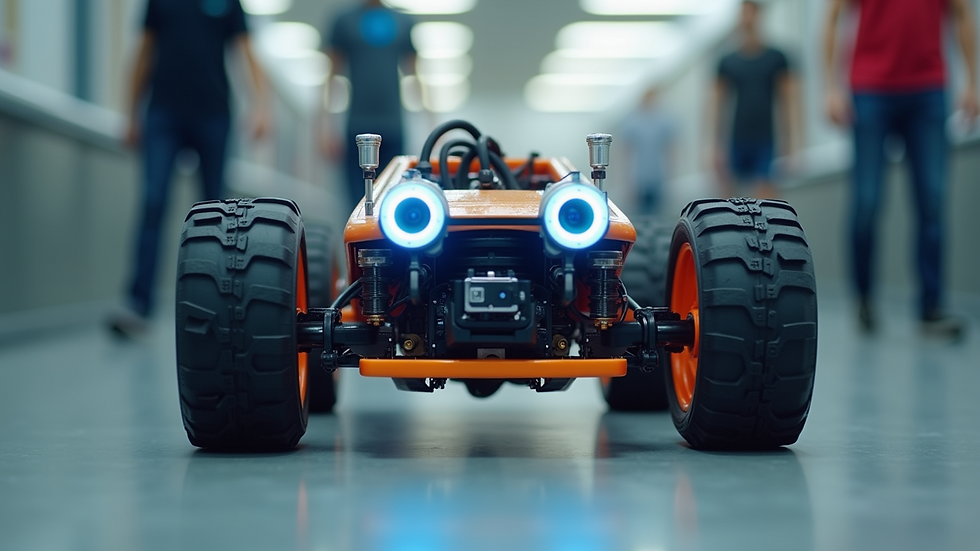Fusion Robotics: Innovative Hardware Solutions
- theteamfusionusa
- Sep 22, 2025
- 4 min read
When it comes to sparking curiosity and creativity in kids, nothing beats the thrill of building and programming robots! Robotics is not just a fun hobby; it’s a gateway to the future. Imagine your child designing a robot that can solve puzzles, navigate mazes, or even compete in exciting challenges like the First Lego League (FLL) or First Tech Challenge (FTC). The secret sauce behind these amazing machines? Innovative robot hardware! Today, I’m diving into the world of robot hardware innovations that are transforming how kids learn STEM skills and prepare for tomorrow’s tech-driven world.

Why Robot Hardware Innovations Matter
Robot hardware is the physical foundation that brings ideas to life. It’s the motors, sensors, controllers, and frames that kids assemble and program to create moving, thinking machines. Over the years, hardware has evolved dramatically, becoming more accessible, affordable, and versatile. This means kids can now experiment with parts that were once only available to professionals!
Here’s why these innovations are a game-changer:
Hands-on learning: Kids get to build real machines, not just code simulations.
Creativity unleashed: Modular parts allow endless customization.
Problem-solving skills: Troubleshooting hardware teaches resilience.
Competition-ready: Advanced hardware helps kids excel in robotics contests.
For example, lightweight aluminum frames and smart sensors enable robots to move faster and react more precisely. This opens up new challenges and learning opportunities that keep kids engaged and motivated.
Top Robot Hardware Innovations for Young Builders
Let’s break down some of the coolest hardware breakthroughs that are perfect for kids from elementary to middle school and beyond!
1. Modular Robotics Kits
Gone are the days of complicated wiring and soldering! Modular kits come with snap-together parts that make building robots as easy as playing with building blocks. These kits often include:
Interlocking frames and chassis
Plug-and-play motors and wheels
Pre-calibrated sensors (distance, light, touch)
User-friendly microcontrollers
This simplicity encourages kids to experiment freely without frustration. Plus, many kits are compatible with popular programming platforms like Scratch or Python, making the learning curve gentle and fun.
2. Smart Sensors and Actuators
Sensors are the robot’s senses, and actuators are its muscles. Recent innovations have made these components smaller, smarter, and more affordable. Kids can now add:
Ultrasonic sensors for obstacle detection
Gyroscopes and accelerometers for balance
Color sensors for line following
Servo motors for precise movement
These parts allow robots to interact with their environment in exciting ways. Imagine a robot that can follow a black line on the floor or detect when it’s about to bump into something!
3. Advanced Microcontrollers and Controllers
The brain of the robot is evolving too! Microcontrollers like the Arduino and Raspberry Pi have become staples in educational robotics. Newer versions offer:
More processing power
Built-in Wi-Fi and Bluetooth
Multiple input/output ports
Compatibility with AI and machine learning tools
This means kids can build robots that not only move but also think and learn. The possibilities are endless!

How Fusion Robotics Supports Learning and Competition
If you’re looking for a trusted source of innovative robotics education , check out fusion robotics. Their education solutions are designed specifically for young learners and competitive teams. Here’s what makes their offerings stand out:
Durability: Robots Built to withstand the rigors of competition and repeated use.
Compatibility: Works seamlessly with popular robotics platforms like FTC and FLL.
Support: Access to tutorials, community forums, and expert advice.
Affordability: Quality education program that fits within school and family budgets.
Using such education , kids can build robots that perform complex tasks, from navigating obstacle courses to completing autonomous missions. This hands-on experience builds confidence and skills that last a lifetime.
Practical Tips for Getting Started with Robot Hardware
Ready to dive in? Here are some actionable tips to help you and your young builder get started with robot hardware:
Start Small: Begin with a simple kit that includes basic motors and sensors. This helps build foundational skills.
Explore Tutorials: Use online resources and videos to learn how each component works.
Join a Team: Robotics teams provide mentorship, motivation, and a chance to compete.
Encourage Experimentation: Let kids try different designs and programming approaches.
Attend Competitions: Watching or participating in events like FLL or FTC inspires and teaches valuable lessons.
Remember, the goal is to make learning fun and engaging. Celebrate every success and learn from every challenge!

Inspiring the Next Generation of Innovators
The world is changing fast, and robotics is at the heart of that change. By embracing the latest robot hardware innovations, kids gain more than just technical skills. They develop creativity, teamwork, and critical thinking. These are the qualities that will help them thrive in any future career.
Whether your child dreams of building robots for space exploration, healthcare, or entertainment, starting with the right hardware makes all the difference. The journey is exciting, rewarding, and full of discovery.
If you want to explore the best hardware options and programs that nurture young engineers, visit fusion robotics today. Let’s build the future together - one robot at a time!



Comments